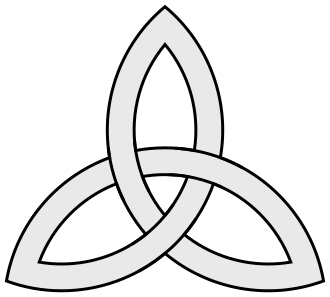Triquetra
The Triquetra; from the Latin adjective triquetrus "three-cornered" is a triangular figure composed of three interlaced arcs, or equivalently three overlapping vesicae piscis lens shapes. It is used as an ornamental design in architecture, and in medieval manuscript illumination (particularly in the Insular tradition). Its depiction as interlaced is common in Insular ornaments from about the 7th century. In this interpretation, the triquetra represents the topologically simplest possible knot.

The triquetra is often used artistically as a design element when Celtic knotwork is used, especially in association with the modern Celtic nations. The triquetra, also known as a "trinity knot", is often found as a design element in popular Irish jewelry such as claddaghs and other wedding or engagement rings.
Celtic pagans or neopagans who are not of a Celtic cultural orientation may use the triquetra to symbolize a variety of concepts and mythological figures. Due to its presence in insular Celtic art, Celtic Reconstructionist use the triquetra either to represent one of the various triplicities in their cosmology and theology (such as the tripartite division of the world into the realms of Land, Sea and Sky), or as a symbol of one of the specific Celtic triple goddesses – for example the battle goddess, The Morrigan. The symbol is also sometimes used by Wiccans, White Witches, and some New Agers to symbolize the Triple Goddess, or as a protective symbol.
Iron Age
The term triquetra in archaeology is used of any figure consisting of three arcs, including a pinwheel design of the type of the triskeles. Such symbols become frequent from about the 4th century BC ornamented ceramics of Anatolia and Persia, and it appears on early Lycian coins.
The triquetra is often found in insular art, most notably metal work and in illuminated manuscripts like the Book of Kells. It is a "minor though recurring theme" in the secondary phase of Anglo-Saxon sceatta production (c. 710–760). It is found in similar artwork on early Christian High Crosses and slabs. An example from early medieval stonework is the Anglo-Saxon frithstool at Hexham Abbey.
The symbol has been interpreted as representing the Holy Trinity, especially since the Celtic revival of the 19th century. It is, however, regularly used as a Trinitarian symbol in contemporary Catholic iconography.
Buddhist tradition
The triquetra has been a known symbol in Japan called Musubi Mitsugashiwa. Being one of the forms of the Iakšaku dynasty signs, it reached Japan with the dynasty's Kāśyapīya spreading technology and Buddhism via the Kingdom of Khotan, China and Korea.[2]